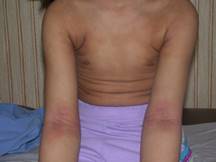What is eczema?
Eczema, or atopic dermatitis (AD), is a skin disease that can be related to allergies and asthma. The rash is generally scaly, itchy and red. It often occurs on the face in young children and on the inner anterior parts of elbows (antecubital fossae) and behind the knees (popliteal fossae) in older children and adults.
Below is a picture of patient with eczema, adult pattern:

Diagnostic Standard of Hanifin & Rajika (this is technical and mostly for doctors):
- Must have three or more basic features described below
- Pruritus
- Typical morphology and distribution
- Flexural lichenification in adults
- Facial and extensor eruptions in infants and children
- Chronic or chronically relapsing dermatitis
- Personal or family history of atopy (asthma, allergic rhinitis, atopic dermatitis)
- Must have three or more following minor features:
- Xerosis
- Ichthyosis/palmar hyperlinearity, keratosis pilaris
- Immediate (type I) skin test reaction
- Elevated serum IgE
- Early age of onset
- Tendency toward cutaneous infections (especially staph. aureus and herpes simplex), impaired cellmediated immunity
- Tendency toward non-specific hand or foot dermatitis
- Nipple eczema
- Cheilitis
- Recurrent conjunctivitis
- Dennie-Morgan infraorbital fold
- Keratoconus
- Anterior subcapsular cataracts
- Orbital darkening
- Facial pallor, facial erythema
- Pityriasis alba
- Anterior neck folds
- Itch when sweating
- Intolereance to wool ad lipid solvents
- Periofollicular accentuation
- Food intolerance
- Course influenced by environmental and emotional factors
- White dermographism, delayed blanch
Eczema may be treated with various creams and ointments and oral medications that are prescribed by either your family doctor or an allergy specialist. Keep skin moist. Immediately (within a few minutes) after bath or shower apply moisturizing agents such as CeraVe, Aquaphor, Keri lotion, or Lubriderm. Use mild soap such as Ivory or Dove. Avoid skin irritation by avoiding itchy clothing such as wool. Wash clothes in mild detergent such as Dreft. Keep house cool, do not overheat bedroom.
Approximately 40% of children with eczema may be positive on skin testing for food. If your child is allergic to foods on skin testing, avoidance of these foods may improve your eczema. This technique of eliminating allergenic foods is particularly important in children. Avoidance of contact with house dust mites and animals and stress is helpful. Oral medications such as antihistamines can help reduce itching. EpiCeram twice daily as a moisturizer may be prescribed, but it will be more expensive than CeraVe. Bleach baths 2-3 times weekly may be recommended by your allergist. Use ¼ cup bleach in ½ tub full of water, avoid exposure to eyes, and soak for 10-15 minutes.
There is a tendency for infections to occur on the skin, particularly with staphylococcus, and if there is crusting, oozing, or pus from the skin, an oral or topical antibiotic may be prescribed.
Topical steroids, are the first anti-inflammatory treatment, and then sometimes CellCept®, but it cannot be used during pregnancy, labs must be monitored, and hepatitis B or C are contraindications.
Dupilimab (Dupixent®) is a new biologic for recalcitrant eczema. It is an anti-IL-4/IL-13 injectible. It has not been FDA approved for children. Prior to resorting to this medication which is expensive, there is a dermatologist who has a combination of topical ingredients which has resulted in miraculous improvement in some of my patients, and referral to him may be worthwhile.